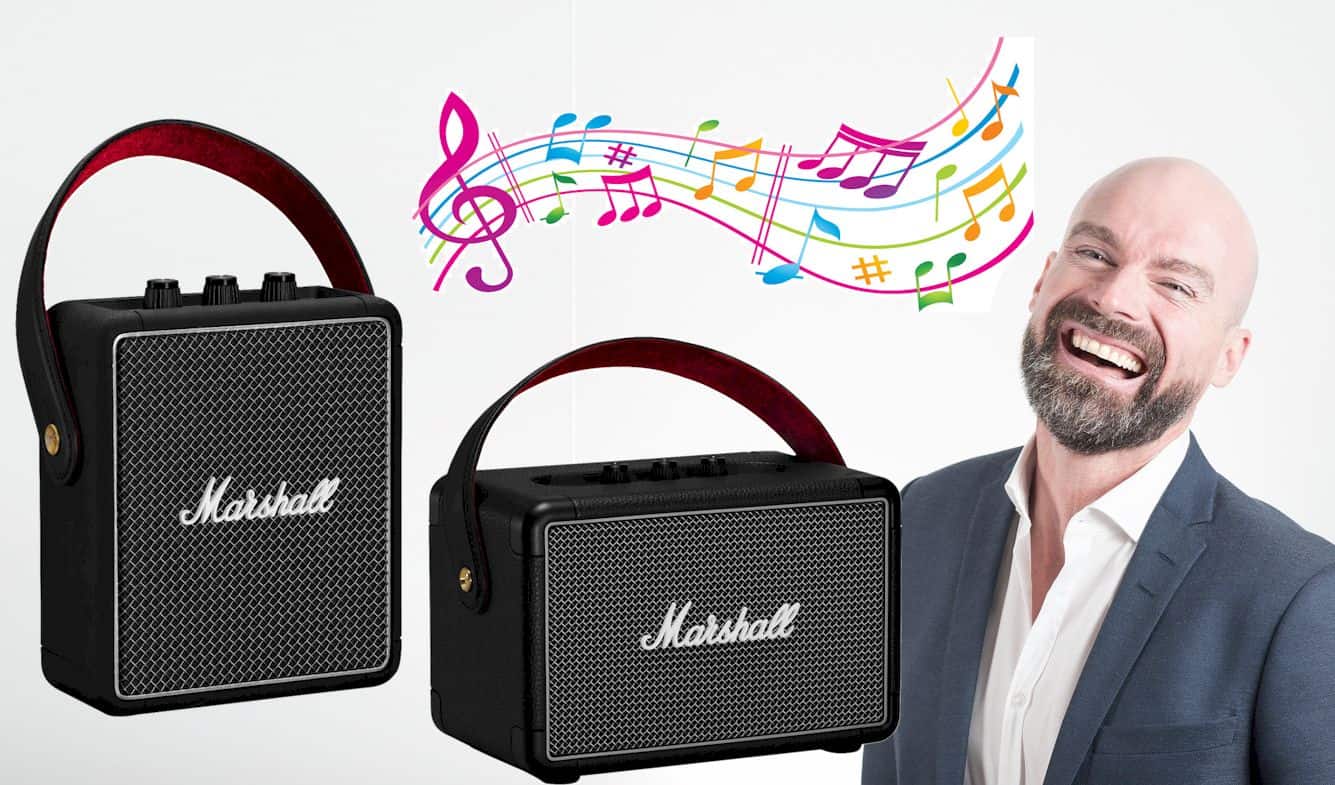They are both portable, compatible with Bluetooth 5.0 devices, and can last for more than 20 hours of playtime. Marshall Stockwell II and Kilburn II are two of the brand’s most exciting models, and this article will help you choose which one fits your needs.
Marshall Stockwell II | Marshall Kilburn II | |
|---|---|---|
Dimensions | 7.09 x 6.34 x 2.76 in | 9.57 x 6.42 x 5.51 in |
Weight | 1.38 kg / 3.04 | 2.5 kg / 5.5 lb |
Water Resistance | IPX4 | IPX2 |
Color | Black, | Black, Grey |
Frequency Response | 60Hz – 20kHz | 52Hz – 20kHz |
Maximum Sound Level | 80 dB SPL @ 1m | 100.4 dB SPL @ 1m |
Woofer | 10W | 20W |
Tweeters | 5 Watt (2x) | 8 Watt (2x) |
Battery Life | 20+ Hours | 20+ Hours |
Wireless Connection | Bluetooth 5.0 | Bluetooth 5.0 aptX |
Connectivity Range | 30ft | 30ft |
Wired Connection | 3.5 mm Input | 3.5 mm Input |
Contents

- A superb general sound profile. Both speakers have deep, punchy, and excellent bass for the size. Each one has an even mix, and both can go loud.
- ‘Old-school’ volume, bass, and treble knobs. Having ‘antique-looking’ knobs on a modern Bluetooth speaker gives it a satisfying and
rare luxury touch . And unlike their analog counterparts, you can quickly adjust basic settings with these knobs, which make it easy to fine-tune to your preference.
- Water-resistant with durable construction. As with other Marshall speakers, both of these babies are solidly built, water-resistant, and can be taken on the road with you. Not to mention the one-year warranty.
- Powerful multi-directional sound. Utilizing Blumlein Stereo to combine the right and left audio channels partially, and direct the sound through the sides, front, and back, both speakers give you a more complete multi-directional sound experience. There are no other speakers of the same size range that can challenge what these can produce sound quality-wise. If you find these speakers with too much reverb and sometimes being out-of-phase, a little reduction in the bass area should fix it. For an even deeper, more powerful bass, place the speakers’ back near a wall.
- Superb battery life. Battery longevity will depend on various
factors but should be more than long enough for an outdoor dance party or a long road trip. You can keep a tab of the remaining juice via the battery indicator. - Bluetooth and 5.0. Both speakers are excellent when it comes to connectivity even at a distance or through walls. The
aptX coding results in higher sound fidelity on supported devices, but the difference is not that noticeable if you’re not a hardcore audiophile. Tests with YouTube, Netflix, and other video and audio streaming services showed no synching issues. You can allow two Bluetooth devices to connect to either of these speakers simultaneously.
But nothing’s perfect, so here are their cons:
- Not waterproof. You might think this is asking too much from speakers that sound and perform this good. They’re already water-resistant, what more do customers want? That’s because some competing speakers in this price range are fully IPX7 waterproof. Stockwell II is rated at IPX4, while the Kilburn II has IPX2. The JBL Boombox and Xtreme2 are completely waterproof and they even float. For a cheaper alternative, you may want to look into Megaboom 3 or Ultimate Ears Boom 3.
- Heavy. The Stockwell II weighs in at around 3.04 lbs while the Kilburn is a heavyweight at 5.5 lbs. Those numbers are not something you'd want to see on portable speakers. And they're not even shockproof, so dropping them should be avoided at all times.
- Not cheap. Well, the price might be worth it, but Marshall speakers don’t really come in mind when looking for budget speakers. But as the saying goes, you get what you pay for, and that’s what you’ll get with Marshall speakers.
Marshall speakers have always been known for their aesthetics and Marshall Kilburn II and Marshall Stockwell II continue to carry that legacy. Both still sport the famous Marshall logo as well as the woven grille. The design just works well.
But these Bluetooth portable speakers are way more beautiful than the older models. Coming in black or gray, the speakers are classy with a modern touch.
The most glaring difference between their designs is the orientation. The Stockwell II is like a vertical rectangle and the Kilburn II is more horizontal. Either way, they still both look amazing. The straps make carrying both speakers comfortable, which are required given their weight.
On paper, both the Stockwell II and Kilburn II boast of more than 20 hours of playtime, but don’t get your hopes up too high. Results may vary and will depend on many factors. If you twiddle with the buttons and tuning knobs a lot, you may drain the battery a little too soon than expected.
Luckily, both speakers offer a Quick Charge feature with slight differences. A quick 20-minute charge of the Stockwell II will give you 6 hours, Kilburn can only squeeze out 3 hours of playtime. Although it looks like Stockwell II takes the cake here, it needs 5 hours to fully charge while Kilburn II takes only half of that.
The Kilburn II comes with a power cord that you plug in at the back. The Stockwell II, on the other hand, requires a USB-C cable for charging. You may want to consider these charging options when choosing the right speaker for you.
Both speakers are Bluetooth 5.0 compatible, which means you can connect a device and play music within 30 feet away. Need two devices to connect to your Bluetooth speaker simultaneously? Marshall Kilburn II and Marshall Stockwell II have got you covered.
Volume, treble, and bass can be customized on both speakers using assigned knobs allowing you to fine-tune the audio output according to your whim. The Bluetooth pairing button is located on the left, while the battery level indicator is located on the right.
When it comes to audio performance, the Marshall brand never fails to deliver. The same can be said for these two Bluetooth speakers. Advances in technology have allowed more audio power to be squeezed into small boom boxes as Marshall Kilburn II and Marshall Stockwell II. They’re both so loud you’ll wonder how the sounds are being produced.
The multi-directional sound technology means you’ll be immersed in your choice of music either indoors or out using a special method to create sounds that seem to emanate from all sides of the speaker.
Stockwell II’s frequency response range is between 60Hz to 20KHz. Kilburn II can produce lower lows with a slightly wider range of 52Hz to 20 kHz. The more powerful Kilburn II also stomps the Stockwell II with its Max Sound Pressure Level set at 100.4 dB compared to the latter’s 80 dB. The same goes for the Woofers and Tweeters. Stockwell II is only rated at 20 watts against Kilburn II’s 36 watts.
Tested side by side, you’ll immediately notice the significant difference between the two. Kilburn II has deeper bass and louder volume compared to its smaller cousin, the Stockwell II.
Although both deliver high fidelity audio with astounding mids and highs, Kilburn II, well, kills the competition.
As mentioned, Marshall speakers don’t come cheap, but they’re really worth every penny. Still, you’d hope that their speakers last longer to get your money’s worth.
Although not as durable as the Megaboom 3 or Boom 3, Marshall Kilburn II and Marshall Stockwell II still hold water when it comes to resistance to wear and tear. Just avoid putting them near pools or other water sources as much as possible. They may be water-resistant, but they can’t be submerged. Tiny water splashes should be fine, though.
The Verdict
Without a doubt, both the Kilburn II and Stockwell II Marshall portable Bluetooth speakers are worthy of the Marshall brand. They are both incredible and fascinating and share common features that place them above the competition.
But similar as they are, each one has unique advantages over the other. And it’s those differences that can help you choose what speaker is the right for you.
Although both are beautifully designed with the classic black or gray color, the horizontal Kilburn II looks more natural than the vertical Stockwell II. Unless the smaller footprint of the Stockwell II has more appeal for you, the Kilburn II is a wiser choice when it comes to design.
Rated at 20 plus hours of playtime, both speakers have enough juice to last a long trip or a visit to the beach. Kilburn II has the advantage of getting fully charged in less time, but Stockwell II is more convenient with the USB-C cable.
Price-wise, Stockwell II costs only half as much as the Kilburn II, so if budget is a constraint, you’ll choose the former. But the added oomph when it comes to bass and volume levels might be enough to sway you over to the bigger, more powerful model.
So is paying a hundred dollars more worth choosing the Kilburn II over the more conservative Stockwell II? If you'll be using your portable Bluetooth speakers for loud-house parties and outdoor music playing, then yes, it's worth it.

HI, John Andrew here. I’ve been an audiophile since I was a little kid. I’m an original member of myaudiolover . It emerged as a way for me to share my passion and knowledge for audio technology. If you’re looking for tips, techniques, and insights about audio-tech, that can enable your productions that professional edge, then MyAudioLover is the place for you!





